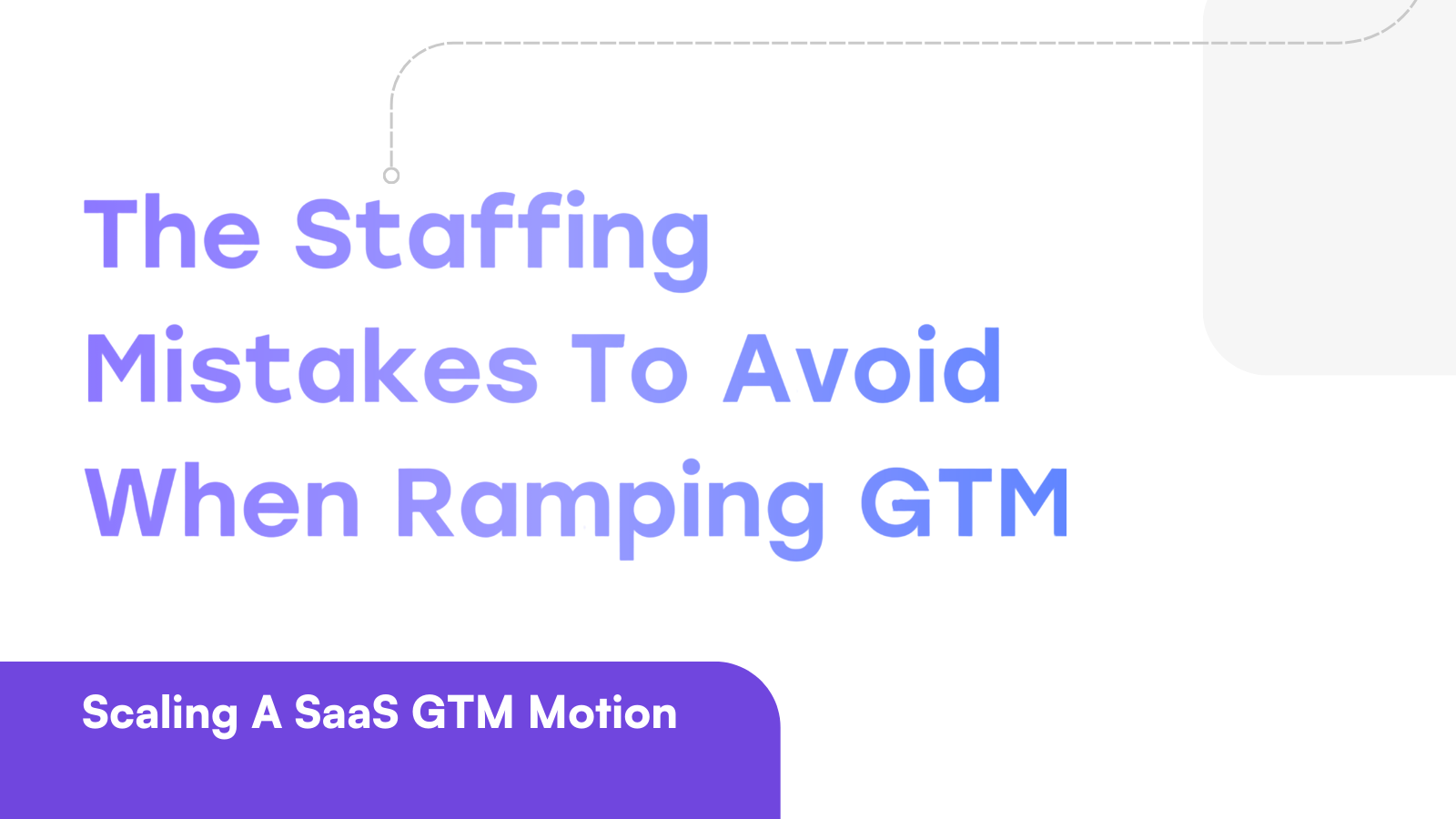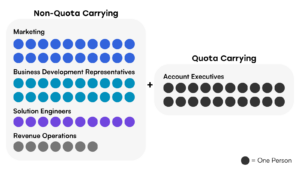
Most SaaS leaders understand the basic structure and function of the go-to-market (GTM) process for acquiring and retaining customers. That is to say, leaders know the importance of lead gen, the function of the account executive (AE), and the helpfulness of a business development representative (BDR).
But often, leaders are less informed of the critical principles and common roadblocks on the path to successfully scaling a GTM function.
And, in a rapidly growing SaaS company, making the right decisions on GTM investments will likely enable a dramatic increase in enterprise value, while making the wrong decisions can destroy enterprise value or permanently slow the trajectory of the business. Said differently, keeping the GTM “train on the track” is much easier than getting it back on the track.
The fact is, a company’s GTM approach can change many times throughout its lifecycle, and leadership must understand the nuances of navigating these changes to avoid painful, ineffective, and/or inefficient outcomes in the build process.
Said another way, early GTM success creates bottlenecks. Managing those bottlenecks over time, and responding quickly to impediments to scale, is a critical SaaS leadership skill that can’t be overlooked, especially in 2025 and beyond.
The Creation of a Standalone GTM Motion
Once a startup hits $1-2M in ARR, the GTM motion must become a standalone, repeatable function. Up until this stage, the executive team is typically selling the product themselves with deep domain expertise and the ability to drive a high degree of customer engagement. Eventually, the executive team hires a few sales reps (we recommend a pod of three) to test the viability of non-CEO selling. At that point, the standalone GTM motion is born — and the principles we’re about to discuss become essential.
Having said that, the transfer of sales ownership from founders to dedicated sales hires isn’t the only time these principles come into play. As a company scales, and the market, competitive landscape, and product all evolve, the GTM motion can, and should, be adjusted.
Understanding how to structure, measure, and scale the motion is critical, no matter the company’s stage or size.
The Two Most Important Principles of GTM Sales
- Predictability: The company can accomplish its goals much faster and with fewer speed bumps if key outputs are measured against relevant inputs
- Example 1: If spend on Google Adwords increases by $5k this month, what incremental lead flow, demo requests, and closed deals will result from the increase?
- Example 2: If another account executive is hired, how long will it take that AE to ramp and what percent of quota will be attained each month for the next year and beyond?
- Efficiency: It’s imperative to understand the ROI for every dollar spent
- Example 1: If another sales ops person is hired, what is the ROI of that hire? How fast will that investment be paid back in terms of new customer revenue?
- Example 2: If an additional GTM software tool is purchased, what incremental benefit will result from this new tool, and what is the associated ROI?
Without predictability, a leadership team will likely embark on a quarterly ‘finger-crossing’ expedition — one where it becomes nearly impossible to make the right investments at the right time. Without efficiency, the company can spend countless dollars in the name of growth and never create value for shareholders.
Ultimately, shareholder value creation is dependent upon achieving consistent predictability and acceptable efficiency in your GTM motion because your ability to win new business drives the rest of the organization. As a successful GTM motion grows revenues, the company has more dollars available to allocate to high ROI endeavors, whether that be in product, customer success, operations, a dividend to shareholders, or furthering the go-to-market motion itself. Let’s dive into how to make that happen.
The First Rule of Scaling A GTM Motion: Protect The Ratios
There’s no way around it: If a company seeks to scale its GTM motion successfully, it must determine, and then protect, GTM ratios.
Every GTM metric revolves around the ratio of employees who carry quota (usually AEs) to every other function within the GTM organization. If there are too few supporting staff (solution engineers, revenue operations, BDRs, etc.) around AEs, the average AE will be less effective, and the sales process may falter. On the other hand, if there are too many supporting staff around AEs, the GTM motion will be prohibitively expensive in relation to new revenue generated. By maintaining healthy ratios of AEs to GTM support roles, the company can ensure its motion will be, and remain, efficient.
Why Do Ratios Matter?
Most of the cost in a GTM motion ties back to people, which means…
If the wrong number of people are completing non-revenue-generating tasks, it will take too long to recover the cost of acquiring a customer.
→ If it takes too long to recover the cost of acquiring a customer, the company will struggle to achieve cash flow breakeven at an appropriate scale;
→ If the company struggles to achieve cash-flow breakeven at an appropriate scale, it will run out of resources and have to significantly reduce headcount, or worse.
On the flip side, with the right ratios, a company can…
→Maximize an efficient growth rate, and
→Facilitate additional investments into product, and
→Drive significant shareholder value.
Bottom line: Ratios are critical. Let’s consider an example to illustrate:
The current GTM team has 20 marketing people, 10 solution engineers, 7 revenue operations people, 10 managers, and 20 business development representatives. None of the marketing, engineering, operations, managers, or business development people are carrying individual quotas. The non-quota carrying team is then paired with 20 AEs that are carrying quota.

With this staffing approach, the company is likely experiencing a very inefficient customer acquisition cost (CAC) payback system (i.e., the time required to pay back the cost to acquire the customer). Because there are too many support staff relative to the number of AEs, ratios are negatively skewed. Under this approach, the company is spending far more on headcount than it generates in new gross margin dollars and the company is likely burning too much cash. As a result, the company seeks to reduce spend, usually through a series of RIFs (reductions in force) to try to get costs down to reduce burn and inefficiency. When this happens, the company loses valuable industry context and organizational momentum, leading to a challenging and time-consuming rebuilding process. Unfortunately, this painful setback often results in decreased product investment and diminished market differentiation.
Don’t Blow Up Good Ratios as The Company Scales
It isn’t just about getting the GTM system right the first time; leaders also need to maintain GTM ratios throughout the growth journey.
Imagine a GTM organization has been staffed appropriately so far, and the company has attained an 18-month CAC payback (time required to recover CAC with new gross margin dollars). In an effort to drive substantial value creation for shareholders, the company will likely seek additional resources to facilitate further growth. And while this can absolutely be the right answer, all too often, the GTM ratios that enabled past efficient growth are discarded in the pursuit of speed and learned practices from executives’ prior experience. Let’s talk through a few examples:
A Marketing Example
Let’s say your company raises $50 million of fresh capital, and you’re growing quickly. It’s time to scale some of your teams.
The head of marketing says, “I only have two or three people on my team, and they’re all stretched really thin. I need a team of 10 people to get everything done.”
Seven new people are hired on the marketing team in response to that logic, but no other teams get additional headcount. Now, the ratio of marketing headcount to account executive and business development representative headcount has been changed.
A few things can happen:
- The work is being spread across more people, but you don’t have a big enough AE team to manage the inbound leads being created by your marketing team’s efforts, OR
- Inbound leads don’t increase, OR
- AEs are highly satisfied with 90% quota attainment well before the quarter ends and opt for working on their Z’s, rather than working all available leads
As a result, system efficiency goes down, meaning that it costs more money to acquire the same amount of net new revenue.
How to Avoid That Scenario
If marketing headcount is increased, lead volume and deal-closing resources (either additional AEs or increased quotas and attainment for existing AEs) need to go up.
To be specific, let’s say things are working well with 20 AEs, eight BDRs, and four marketing people. To keep your ratios balanced, you should get to 40 AEs and 16 BDRs (or double attainment of the existing team) before you hire four additional marketing team members. That way, your ratio of inbound opportunities to resources for managing those opportunities stays balanced. Some tweaks in ratios can certainly be introduced if the current motion is highly efficient, but changing those ratios dramatically will create painful efficiency problems. For example, you may decide that you don’t need 16 BDRs to support 40 AEs but need 3 additional marketing people to better analyze and allocate marketing program spend. That can work, but you’ll need to closely watch the comprehensive team ratio of non-quota-carriers to those who carry a quota.
A RevOps Example
Your company reaches $20 million in ARR. At that point, your Head of Sales says, “I want to hire a revenue operations (RevOps) team now. I’ve only had one person so far, and I want to scale to six.”
RevOps is a role that provides valuable analytical horsepower that can effectively support the sales motion; on the surface, adding five RevOps people sounds like a great idea. The problem is, those additional five people don’t carry quota. Despite the immense analytical value they can provide, they don’t generate new leads or close new deals. Unfortunately, the CAC payback ratio (critical to overall efficiency) will take a significant hit. Essentially, you’ll end up spending more on sales and marketing expenses without a commensurate rise in sales, driving down the efficiency of the organization. Again, that’s not to say that RevOps isn’t a highly valuable function. In fact, it is incredibly valuable. But, the ratio of RevOps team members hired into that function has to align with the efficiency goals of the GTM organization comprehensively.
A Better Way: Again, an excellent RevOps hire can drive dramatic value in the sales process and visibility of the motion. Hire a resource or two and allow those team members to exert influence throughout the motion. Empower them to go beyond creating reports in PPT and Excel by becoming data-driven enablers of the sales function. Enabling 1-2 team members to drive significant insight, visibility, and value can be much more productive than hiring a team of 5-6 who struggle to fill their day with value-added work.
The Campaign Spend Example
It’s not always hiring requests that affect your ratios. Let’s say your organization is spending $1 million a year on digital marketing campaigns to drive leads. Your company receives additional capital, and you decide to increase your digital marketing spend to $10 million.
Your marketing efforts have created a surge of leads coming in the door, but the number of BDRs and AEs on your team hasn’t changed. Without enough people to process all those leads — you guessed it — you’re going to significantly impact your efficiency, as you’ve increased spend without a commensurate rise in sales. Alternatively, if the cost to generate each additional lead increases meaningfully (i.e., the first $1M results in 100 leads and the last $1M results in 10 leads), then the cost to acquire a customer increases dramatically without changing headcount.
So, if the company is growing well and efficiently, yes, you should spend more for lead acquisition. But, you should commensurately ensure you have additional lead qualification, lead closing, and customer upselling resources to ensure you get what you intended from that additional campaign spend.
Being Careful with Ratios Is Critical But Incomplete…
GTM leaders also should understand —and get ahead of — hiring curves, particularly the quota-carrying rep hiring curve. In other words, going back to the principles of predictability and efficiency, leaders need to understand clearly (and continually track) the following activities in preparation for hiring timing to drive continued predictable and strong growth:
- How long it takes to find a recruiter
- How long it takes for that recruiter to get candidates
- How long it takes to get through the interview process and narrow down the candidate pool
- How long it takes to get an offer out
- The likelihood of a candidate accepting an offer
- The success rate of hires in that role
- IF that hire is successful, how long it takes to ramp to quota attainment
With the everyday demands placed on a GTM team member or leader, it’s very easy to assume that “additional resources can be available as soon as needed.” The reality? GTM roles tend to have a ~50% success rate. Success in sales is highly dependent upon the ability of a salesperson to be self-motivated and fast learning, which is difficult to evaluate in an interview process. Moreover, it can take three months to hire someone and 6 months to ramp that person into a sales role.
The good news: Armed with the right timeline data above, leaders can work backward based on the sales capacity needs of the company and stay ahead of the hiring curve. In addition, it is often advisable for companies to have a 20-30% sales capacity buffer. With that buffer, and a clear understanding of the hiring curve, revenue generation will be more predictable. (Bonus: the same principle applies to lead-gen capacity planning.)
To Sum Up
There’s no way around it. Controlling GTM ratios takes discipline and a detail-oriented mindset, especially in a high growth SaaS organization. The GTM motion will need to continue to evolve over time as strong growth will create bottlenecks and can break existing processes (good problems). When leaders effectively control ratios and manage the hiring curve in a timely way, the company can avoid the barriers to predictability and efficiency that plague many SaaS companies as they grow.
Ping the Sorenson Capital team to learn more.
Go get ‘em!





